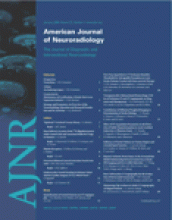Abstract
Summary: We report a case of pantothenate kinase-associated neurodegeneration with increased regional cerebral blood flow (rCBF) in bilateral lentiform nuclei on technetium Tc-99m ethyl cysteinate dimer single-photon emission CT (ECD-SPECT). A 6-year-old boy presented with opisthotonus. T2*-weighted MR images revealed areas of marked hypointensity with a hyperintense focus in bilateral globus pallidus, creating the characteristic eye-of-the-tiger appearance. ECD-SPECT showed increased rCBF in bilateral lentiform nuclei.
Pantothenate kinase-associated neurodegeneration (PKAN,previously known as Hallervorden-Spatz syndrome) represents an autosomal recessive disorder characterized by dystonia, Parkinsonism, and iron accumulation in the brain. Findings on MR imaging have been described elsewhere,1-4 but no previous reports have described brain perfusion studies on single photon-emission CT (SPECT) or positron-emission tomography. We describe the case of a 6-year-old boy for whom brain perfusion SPECT was performed.
Case Report
A 6-year-old boy presented with opisthotonus. His mother had a history of threatened premature delivery, but he was born by normal vaginal delivery. Development by 1 year of age had been normal. He tended to fall down while walking, and fell backward even when sitting. Verbal development was delayed. Involuntary movements of the right upper extremity began at 4 years of age, and was unable to walk at 5.25 years of age. He was subsequently fed by nasogastric tube. Opisthotonus began at 6.5 years of age.
Emaciation was noted on admission, along with urinary and fecal incontinence. On CT images, calcification was noted in bilateral globus pallidus, and the brain was slightly atrophic.
On T2-weighted MR imaging, areas of marked hypointensity with a focus of signal intensity hyperintensity were evident in bilateral globus pallidus, creating the characteristic eye-of-the-tiger appearance. The lesion showed more prominent hypointensity without hyperintensity foci on T2*-weighted images (Fig 1). Cerebral and cerebellar atrophy were also noted.
T2*-weighted MR imaging shows an area of marked hypointensity in the globus pallidus.
Technetium Tc-99m ethyl cysteinate dimer SPECT (ECD-SPECT) revealed prominent accumulation on the medial side of bilateral lentiform nuclei (Fig 2).
Transaxial (A) and coronal (B) SPECT images with Tc-99m ECD-SPECT show prominent accumulation in bilateral basal ganglia.
Deep brain stimulation (DBS) of the globus pallidus internus was performed bilaterally. Opisthotonus was markedly decreased after DBS. SPECT images 9 weeks after DBS revealed slightly decreased accumulation in this area. After 19 weeks, hypoperfusion was noted in the right frontotemporal region and basal ganglia, predominantly on the right (Fig. 3).
SPECT image 19 weeks after DBS. Perfusion is decreased in the right globus pallidus and frontotemporal region. Color setting differs from the initial study due to replacement of the gamma camera and related equipment.
Discussion
Many cases of Hallervorden-Spatz syndrome have recently been found to result from mutations in a gene located on chromosome 20p13. All patients with classic Hallervorden-Spatz syndrome and one third of those with atypical disease display PKAN2 mutations. In all patients with PKAN, whether classic or atypical, T2-weighted MR imaging of the brain displays a specific pattern of hyperintensity within the hypointense medial globus pallidus. This pattern is not seen in patients without mutations.1
On the basis of clinical assessment, early-onset childhood-type (1a) PKAN with rapid progression was diagnosed in this case.5
Prominent accumulation at the medial side of bilateral lentiform nuclei was noted on ECD-SPECT. In patients with epilepsy or convulsions, perfusion in the basal ganglia on ECD-SPECT is reportedly higher in patients younger than 1 year than in older patients.6 Perfusion in the basal ganglia is stable after 1 year of age. Because this patient was 6 years old, hyperperfusion in the lentiform nuclei seems significant.
In epilepsy patients, hyperemia occurs at the epileptogenic focus during ictal status, but perfusion decreases during interictal status at the focus. In this case, SPECT was performed during interictal status. The medial sides of bilateral lentiform nuclei might have acted as continuous epileptogenic foci.
Neurochemical abnormalities have been found in PKAN, with markedly elevated levels of cysteine and glutathione cysteine mixed disulphide in the globus pallidus associated with reduced activity of cysteine dioxygenase.7 Accumulated cysteine may act as a chelating agent and might be responsible for the accumulation of iron. Radiopharmaceuticals such as technetium Tc-99m ECD may also be chelated by cysteine in the globus pallidus.
Recently, DBS of the globus pallidus has emerged as a significant therapeutic alternative in intractable dystonia, including PKAN.8 DBS of the globus pallidus internus seems effective for dystonia, because the process removes the source of inhibitory input to the thalamus and normalizes thalamic neuronal activity. This patient showed decreased perfusion in the right globus pallidus and frontotemporal region after DBS. Decreased perfusion in the right front-temporal region may be due to remote effects.
Acknowledgments
We thank Dr Ryouichi Okiyama, neurologist, for the clinical advice.
References
- Received November 7, 2004.
- Accepted after revision February 11, 2005.
- Copyright © American Society of Neuroradiology















